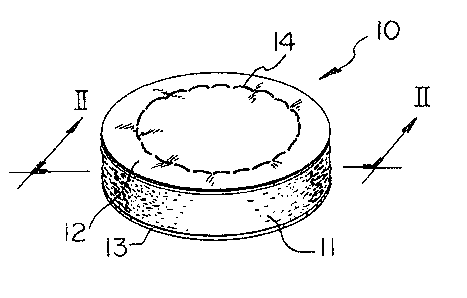Note: Descriptions are shown in the official language in which they were submitted.
:CNTROVUCTION
.
This invention relates to a Eloor hockey pl~ck and,
more particularly, to an improved floor hockey puck which
is intended to be used primarily indoors.
BAC~GROUND OF THE INVENTION
In countries where winter is a significant season,
ice hockey is a popular sport. Because of the rigorous
physical activity involved in playing the sport, combined
with the co-ordination necessary to excel, it is also a
favoured activity for fitness purposes and, in particular,
for fitness activities involving school children.
However, the vagaries of the outside ice conditions,
coupled with time constraints in physical education
classes and the outside weather often dictate that the
hockey be played inside. As such, indoor floor hockey has
evolved to a popular sport and fitness activity in its own
right.
The pucks presently used in floor hockey are
typically, plastic-like pucks of the same general
dimensions as an ice hockey puck. These plastic pucks,
while being durable, do not properly simulate the motion
of an ice hockey puck, they leave the floor frequently
when struck by a stick, they are non-deformable and hard
36~;3
- 2 -
and there~ore stiny when hitting people which can cause
apprehension and an outright refusal to play by the
participants. Other pucks have a].so been used in
various configurations and of various other materials
but they all suffer from disadvantages similar to those
mentioned.
SUMMARY OF THE INVENTION
According to the invention, there is disclosed a
floor hockey puck in the form of a cylindrical disc
having the approximate shape and size of a conventional
ice hockey puck, said puck comprising an inner
relatively thick layer of felt-like material and two
outer relatively thin discs of leather-like material,
said inner layer being substantially continuous
throughout its volume between said two outer discs and
means connecting each of said outer discs to the
opposite sides of said inner layer.
BRIEF D~SCRIPTION OF THE SEVERAL VIEWS OF THE DRAWINGS
A specific embodiment of the invention will now be
described, by way of example only, with reference to the
accompanying drawings in which:
'k~
," V',j~
~ ~3~ 3
--3--
Figure l is an isornetric view of the eloor hockey
puck according to the invention; and
Figure 2 is a sectional view taken along the plane
II-II of Figure l.
DESCRIPTION OF SPECIFIC EMBODIMENT
Referring now to the drawings, the floor hockey puck
according to the invention is generally shown at 10 in
Figure l. It comprises a felt inner layer ll sandwiched
by two relatively thin leather discs 12, 13 located on
opposite sides of the felt inner layer 11. The
circumferences of the felt inner layer ll and the
oppositely located discs are generally similar and have
the same general diameter as a regular ice hockey puck,
namely about 70 - 75 mm. The puck also has approximately
25 mm.
Stitching 14 is used to Easten the outer leather disc
12 to the felt inner layer 11 as illustrated. The
stitching u~ed can be, for example, waxed or nylon
thread. The distance of the stitching from the
circumference of the puck is approxima-tely 8 mm. as
illustrated in Figure 1. The stitching length of
approximately 10 mm. as illustrated has also been found to
be suitable.
_fi_
The thickness oE the felt layer is approximately 20
mm and leather having a weight of approximatel~ 4 to
6 oz./square foot has been found satisfactory as material
for the outer discs which sandwich the felt inner layer 11.
While the materials disclosed and the dimensions
given in the specific embodiment have resulted in a very
suitable floor hockey puck with the desirable attributes
of lightness, softness, smooth operation on floors and
durability, it is clear that other materials having
similar characteristics to the felt and leather disclosed
would also fall within the scope of the invention. For
example, leather-like simulated material such as vinyl
could be used for the two disc-like covers 12 and 13 and a
felt-like simulated material could be used to replace the
actual felt layer 11 speciEied. '~he combination of a
number of pieces of leather or felt or similar material
could also be used rather than the single pieces
described. Insofar as the stitching specified is nylon,
which stitching is used to connect the disc covers and the
felt layer, other stitching or fastening means could also
be used. Stitching or other soft connection means,
however, is preferable as narrow hard portions are not
present in the floor hockey puck according to the
invention and the absence of hard areas is desirable to
prevent injur~.
. ~ .
.,
~3~
^- --5--
In respect of the dimensions yiven, it is clear that
even substantial dimensional changes can be made, either
for efficient manufacture or other purposes which will not
adversely affect the desirable characteristics of the puck
when in operation. The dimensions of the floor hockey
puck given above, however, have proven to provide
excellent handling and wear characteristics.
Many other modifications may be made to the specific
embodiment of the invention described and such description
should be taken as illustrative only and not as limiting
the scope of the invention as defined in accordance with
the accompanying claims.
